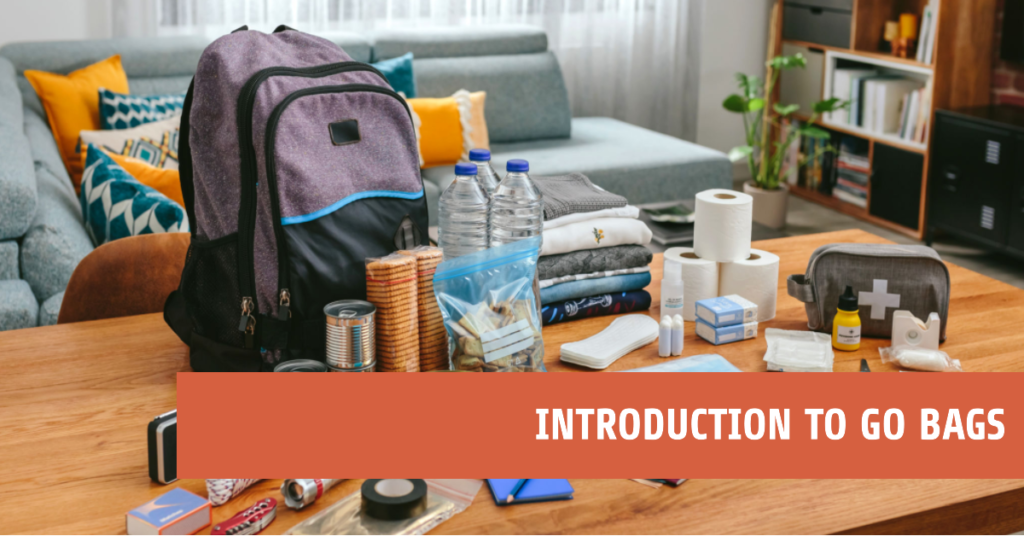
Picture this: an unexpected disaster or emergency arises, and you have just minutes to evacuate or take shelter. Will you be ready? This is where a Go Bag comes in handy. A well-prepared Go Bag can be your lifeline during a crisis, providing the essentials to survive and stay safe.
This article will dive into Go Bags, discuss the different types, and explore the importance of having one ready to go.
What is a Go Bag?
A Go Bag, a bug-out bag, emergency bag, or survival kit, is a portable, pre-packed bag containing essential items needed to survive in various emergencies. It’s designed to be grabbed quickly in case of an evacuation or disaster, allowing you to focus on getting to safety without worrying about gathering supplies.
Types of Go Bags
There are several types of Go Bags, each tailored to specific scenarios and needs. Some common types include:
- Bug Out Bag (BOB): A BOB is designed to help you survive for at least 72 hours after evacuating your home during a disaster. It typically includes food, water, clothing, first aid supplies, tools, and other essential items.
- Get Home Bag (GHB): A GHB is intended to assist you in getting home safely during an emergency. It’s usually stored at your workplace or in your vehicle. It contains essential items to aid you in reaching your home or designated safe location.
- Everyday Carry (EDC): An EDC is a smaller, more compact kit of essential items you carry daily. It typically includes a multitool, a flashlight, and a small first aid kit.
- Vehicle Emergency Kit: This kit is designed to be kept in your vehicle and includes items specific to roadside emergencies and vehicle repair.
What to include in my go bag?
What to include in your go bag can depend on your specific situation, location, and members in your family. Some items may not be needed for everyone (baby formula for example) so make sure you consider your specific needs.
Here’s a list of the items we consider essential to include in your Go bag to give you a good base to build off of. Feel free to add additional items as you see fit.
Essential:
- Water (bottled or hydration system): Crucial for hydration and cooking, aim for a minimum of 3 liters per person per day.
- Non-perishable food (energy bars, freeze-dried meals): Provides the energy needed to survive, choose calorie-dense and lightweight options.
- First aid kit: Basic medical supplies to treat minor injuries and illnesses, such as band-aids, gauze, and pain relievers.
- Multi-tool or knife: Versatile tool for cutting, opening cans, and other tasks, can be life-saving in various situations.
- Flashlight with extra batteries: Essential for visibility in low-light conditions, choose a durable, water-resistant model.
- Emergency whistle: Aids in signaling for help, especially when voice may not carry far enough.
- Local maps and a compass: Navigate unfamiliar terrain, even without electronic devices or cell service.
- Emergency shelter (emergency blanket, lightweight tarp): Provides protection from the elements in case of unplanned overnight stays.
- Fire starter (matches, lighter, or ferrocerium rod): Enables fire-making for warmth, cooking, and signaling.
- Portable water filter or purification tablets: Ensures access to safe drinking water by removing pathogens and impurities.
- Extra clothing (change of socks, hat, gloves): Helps maintain body temperature and prevent hypothermia, especially in wet or cold conditions.
- Personal hygiene items (toothbrush, toothpaste, toilet paper, hand sanitizer): Maintains cleanliness and prevents illness.
- Important documents (copies of ID, insurance, emergency contacts): Facilitates identification and access to essential services during emergencies.
The Importance of Having a Go Bag
A Go Bag is an essential part of any emergency preparedness plan. In a disaster, you may need more time to gather supplies, and basic services could be disrupted for an extended period. Having a Go Bag allows you to:
- React quickly: With a Go Bag, you can focus on getting to safety instead of spending precious time gathering supplies.
- Stay self-sufficient: A Go Bag ensures you have the essentials to survive and stay safe without relying on external assistance.
- Reduce stress and anxiety: Knowing you’re prepared for emergencies can provide peace of mind and help alleviate stress during a crisis.
Assessing Your Personal Needs and Situation
When building your Go Bag, it’s crucial to consider your personal needs and unique circumstances. Your location, climate, medical conditions, and family members (including pets) should all be considered when selecting items for your Go Bag.
Customizing Your Go Bag for Specific Emergencies
A well-prepared Go Bag is essential for any emergency, but customizing it to address specific situations can significantly increase its effectiveness. By considering potential scenarios you may encounter, you can ensure your bag covers all essential needs for a variety of emergencies.
Natural Disasters
Different natural disasters call for specific items to ensure your safety and well-being. Here are some recommendations based on common natural disasters, you can read more about emergency preparedness for natural disasters here.
Earthquakes
For earthquakes, include a dust mask to protect yourself from airborne particles and debris. Work gloves will protect your hands from sharp objects and rough surfaces during rescue efforts or while navigating damaged structures. A whistle can help signal for help if you’re trapped.
Hurricanes
Hurricanes often bring strong winds and heavy rainfall. Waterproof bags or containers can keep your important documents and electronic devices dry. A portable radio with extra batteries will allow you to stay informed on weather updates and evacuation orders.
Floods
In case of floods, high-quality waterproof boots and extra layers of clothing are essential. You may also want to include inflatable flotation devices or a compact life jacket to help you stay afloat in deep water.
Wildfires
Wildfires produce smoke and poor air quality. Consider adding a smoke hood or respirator to protect your respiratory system. Additionally, pack fire-resistant gloves and a fire blanket to protect yourself from heat and flames.
Man-made Disasters
Man-made disasters, such as terrorism or civil unrest, require different considerations in terms of safety and self-preservation.
Self-Defense Items
In case you need to protect yourself or your loved ones, self-defense items such as pepper spray or a tactical flashlight can be useful. Be sure to research local laws and regulations to ensure you’re carrying legal items.
Concealable Body Armor
For personal protection in high-risk situations, consider adding lightweight, concealable body armor to your Go Bag. Choose a level of protection appropriate for the threats you may face.
Gas Mask
A gas mask can protect you from harmful airborne chemicals, smoke, or tear gas during a man-made disaster. Ensure your mask has the appropriate filters for the specific threats you may encounter.
Extra Cash
In times of crisis, you may need to purchase essential supplies or pay for transportation. Keep a stash of extra cash in small denominations in your Go Bag, as credit cards or electronic payments may not be available during emergencies.
Personal Emergencies
Some emergencies are more personal in nature, such as house fires or medical emergencies. Customizing your Go Bag for these situations is crucial for your safety and well-being.
House Fires
For house fires, a fireproof document bag can protect important documents and valuables. Additionally, a fire escape ladder can provide a safe exit from a multi-story building if primary exits are blocked.
Medical Emergencies
A comprehensive first aid kit is essential for treating injuries during emergencies. Be sure to include any necessary prescription medications and medical supplies specific to your needs, such as an epinephrine auto-injector for severe allergic reactions or an inhaler for asthma.
Maintaining and Updating Your Go Bag
A well-prepared Go Bag is essential during emergencies, but its effectiveness relies on proper maintenance and regular updates. Ensuring your bag’s contents are in good condition and relevant to your needs is crucial for optimal preparedness.
Inspecting Your Go Bag
Regularly inspecting your Go Bag will help identify any worn-out, damaged, or expired items. Replace these items promptly to ensure your bag remains effective during emergencies.
Food and Water
Food and water supplies in your Go Bag have a limited shelf life. Check the expiration dates on these items and replace them as needed. Consider using long-lasting, non-perishable options such as freeze-dried meals and water purification tablets.
First Aid Supplies
Inspect your first aid kit for any damaged or expired items. Replace them with fresh supplies, and ensure you have adequate quantities of essential items such as bandages, antiseptic wipes, and pain relievers.
Batteries and Electronic Devices
Check batteries in your electronic devices, such as flashlights and radios, to ensure they are fully charged and functioning correctly. Replace any dead or leaking batteries and consider using rechargeable options or devices with alternative power sources, such as solar or hand-cranked chargers.
Adapting to Changes
Your personal circumstances and needs may change over time. Regularly reassess your Go Bag’s contents to ensure they remain relevant to your current situation.
Family Changes
If you have a new family member, such as a baby or a pet, ensure your Go Bag includes items to accommodate their needs. This may include diapers, formula, pet food, and additional water supplies.
Health and Medical Needs
Keep track of any changes to your health or medical conditions. Update your Go Bag with necessary prescription medications and medical supplies tailored to your specific requirements.
Location and Climate
If you move to a new location or experience significant changes in climate, update your Go Bag accordingly. For example, consider adding warm clothing for colder climates or insect repellent for areas with high mosquito populations.
Seasonal Adjustments
Adapt your Go Bag to the changing seasons to ensure you are prepared for weather-related emergencies.
Warm Weather
In warm weather, include items such as lightweight clothing, sun protection, and extra water supplies to prevent dehydration.
Cold Weather
For colder months, pack additional layers of clothing, hand warmers, and a compact emergency blanket to retain body heat.
Regular Practice and Training
Familiarize yourself with the contents of your Go Bag and practice using the items to build confidence and competence. This will help you respond more effectively during an emergency.
Using Your Gear
Take the time to learn how to use your gear, such as setting up an emergency shelter or starting a fire with a firestarter. Practice these skills regularly to ensure you can perform them efficiently during a crisis.
Emergency Drills
Conduct regular emergency drills with your family to practice evacuating and using your Go Bag. This will help identify any gaps in your preparedness plan and build confidence in your ability to respond to emergencies.
Ready to start building your Go Bag? Check out our comprehensive guide on Essential Go Bag Items to ensure you’re well-prepared for emergencies.
Remember, a well-prepared Go Bag is your lifeline during emergencies and disasters. Don’t wait for a crisis to strike – start preparing today!
